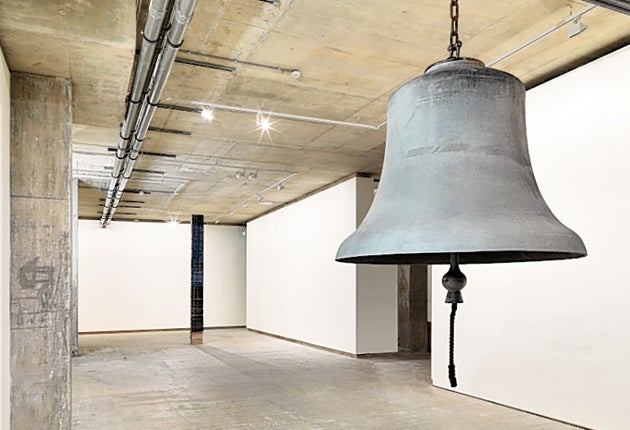Fiona Banner: The Naked Ear, Frith Street Gallery, London

Fiona Banner's current installation in the Duveen Galleries at Tate Britain, Harrier and Jaguar (2010), sees two fighter planes dominating one of the grand spaces of the museum. It's an uncomfortable triple sublime: force x power x impressive aesthetics, but oddly underwhelming as art. Elsewhere in London, at Frith Street Gallery, is a literal echo of that installation. An enormous bell greets you at the gallery, hung low from supports in the ceiling. The sculpture is ominously named Tornado (2010) has been cast from the melted-down fuselage of a Tornado jet fighter – a deadly efficient machine of war. For whom does this bell toll? The idea of a deep, sonorous bell ring rings with signification: the passing of time, births, deaths and marriages. A large single bell like this, however, given its name and its history, is more likely to bring to mind mourning, warning and doom. The death-knell. How many times did this particular plane bring about death and destruction? Nearby is a stack of every copy of Jane's All the World's Aircraft, from 1909-2010. A heap of language that describes only destructive capability and armature, freed from the bloodshed, the conflict and the history of the wars for which such impressive machines are made.
The exhibition is dragged down somewhat by Banner's ISBN works downstairs – unique text pieces that play on the idea that everything with an ISBN number must put a copy in the British Library. Not so, if the number is carved only once on a gravestone, you see? The standout work of the exhibition, however, is, 1066, the latest in the artist's series of "wordscapes", in which she writes highly detailed descriptions of events (such as the war film Black Hawk Down) on a wall as they unfurl. In 1066, the artist describes the events of the Battle of Hastings, as depicted by the Bayeux Tapestry.
As one reads the description, walking up and down the walls of the gallery in order to do so, it is an amalgamation of images from war films that blossom in the imagination, rather than images intricately embroidered by nuns. We follow the action, as though hearing a shot-for-shot description of a Ridley Scott movie. We hear the words of Harold's rousing speeches to his soldiers (this part surely going, in our imaginative casting, to Russell Crowe). In battle, we see "fountains of red blood puking" from open wounds, a horse falling "like a car crash".
The conflation of sexuality and war are never far away in Banner's descriptions (and neither, one guesses, are gleeful thoughts of the nuns who created the tapestry's imagery). The language is as earthy as the English soil, which is being fought over: a soldier's dagger is "protruding from his waist like a big cock", and descriptions of horses' members, erect or flaccid, reappear constantly throughout the text. We suffer and enjoy the gory battle from start to finish, an image of the tapestry now glinting in our minds with grim, blood-spattered life. The sound of violence is everywhere, even in this silent room. Here is just a pile of books, a jumble of words and a silent monument. But here also is a dark history of an island, forever at war.
To 15 January (020 7494 1550)
Join our commenting forum
Join thought-provoking conversations, follow other Independent readers and see their replies
Comments